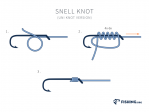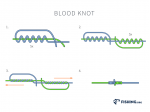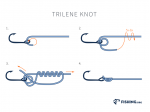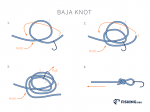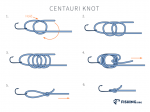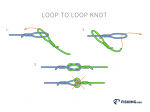San Diego Jam Knot

Tying a San Diego Jam Knot Can Get you out of a Jam
Step 2:
Step 3:
Step 4:
Our Take:
The popularity of the knot began in the sport-fishing capital of San Diego, California. Hence, the fitting name of the San Diego Jam Knot. But it goes by other names.
Some fishermen and women know this knot as the Reverse Clinch Knot or Heiliger Knot.
Thanks to the tuna fishermen and women of San Diego, the popularity of this knot grew amongst the fishing community.
The knot continued to gain widespread recognition by anglers outside of California and the San Diego Jam Knot, which fishermen and women still use all over the world to this day.
When to Use a San Diego Jam Knot
Anglers use this knot when attaching a line to a swivel hook, artificial fly, or clip. Anglers can tie the San Diego Jam Knot with many types of fishing lines including fluorocarbon, monofilament and braided fishing lines.
It is a strong knot, but it can sometimes be even more potent than the strongest knot called the Palomar knot. As Palomar is a great knot, it loses its power when used with a mono fishing line. It works better to use with a braided wire or fluoro line.
But because of this, the San Diego Jam Knot has won rave reviews with fishermen and women.
Everyone wants to know how to tie the San Diego Jam Knot, but before learning the steps, find out what causes knots to slip while fishing.
Correct Tying of the San Diego Jam Knot Is Paramount
While fishing, two-knot issues can pop up that put you in a jam. One problem is knot slippage and the other, knot breakage.
First, find out the common reasons both knot issues arise. Then learn how to tie the San Diego Jam Knot properly to ensure you can avoid these fish-catching jams.
Why Do My Fishing Knots Keep Slipping?
By the time you go fishing, you already know how many fish you want to catch. What you are not thinking about is how many times will you need to re-tie your knots.
Knot slippage occurs for two reasons:
- Wrong Fishing Knot:
It is essential to know when and where to use each fishing knot. It is also crucial to understand which knot works best with each kind of fishing line.
- Improper Knot Tying
Every fisherman and woman should re-check their work before casting their fishing rod. If improperly tying the right knot occurs, the knot will slip out, causing you to lose your catch.
Another problem that can emerge is that of knot breakage.
What is Causing My Fishing Knot to Break?
Similar to knot slippage, breakage also occurs for two reasons.
- Too Much Strain
If the tension on the knot exceeds the knot’s strength, your knot will eventually break.
- Improper Tying of the Knot
Again, similar to what causes slippage issues, fishing knot breakage happens when anglers improperly tie the knot. This will cause it to break under pressure that does not exceed potential knot strength.
This reiterates the importance of knowing your lines and knot strengths. You also need to know when, where, and with which line you should use a knot.
To avoid further knot slippage or breakage when using the San Diego Jam Knot, here are the instructions on how to properly tie one.
Correctly Tie a San Diego Jam Knot
The San Diego Jam Knot is more likely to keep the strength of the line better than most knots (holds 95% line strength), which is a significant reason it can help prevent slippage and breakage.
When tuna fishermen and women want to tie a knot to the iron jigs, the San Diego Jam Knot is an excellent choice. This knot is quick to tie and is very reliable.
Thus, if you want to save time while maximizing your line strength, this knot is for you.
4 Easy to Follow Steps to Tie a San Diego Jam Knot
Once you try the San Diego Jam Knot, you will be glad you did. Look it into memory and take that knowledge with you each time you go fishing.
San Diego Jam Knot Tying Instructions
Step 1: Pass the end of the main line through the hook eye or lure.
Step 2: Loop the tag end over your index finger and make seven wraps around the double line down to the eye.
The total number of turns should decrease in size and range from seven to eight turns for a 10-pound line down to three wraps for a line that weighs about 40-pounds.
Make sure your turns do not overlap. They should form a neat spiral when you are tightening your knot.
Step 3: Feed tag end between the double lines below the last wrap. Then bring it back to the loop made with your index finger. Next, run through the loop knot and remove your finger.
Step Four: Moisten the lines and pull the tag end tight.
Conclusion
Familiarize yourself with the proper usage of each knot you use, including the San Diego Jam Knot.
Check for knot slippage or breakage before going fly-fishing, freshwater, or saltwater fishing. Once you know how to tie the San Diego Jam Knot correctly, you can prevent fishing jams from occurring.
 Carla Arbuckle
Carla Arbuckle 
